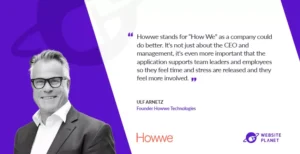Don’t waste time. Strategies can be a week, a month, or a year. Don’t waste time setting a longer strategy, prioritize making the necessary changes happen.
Article written by Authority Magazine Editorial Staff as part of their series about the “How Businesses Pivot and Stay Relevant In The Face of Disruptive Technologies”.
Background:
Ulf Arnetz is a Swedish 3x entrepreneur, who is now based in NYC working with his company Howwe Technologies, a SaaS company delivering acceleration software for CEOs.
Ulf has done the same international expansion where initial sales, delivery, and proofs started in Sweden and then expanded directly to the U.S. market. His successes include IOS, where he was the founder and CEO, which was sold to Nasdaq-listed Cambridge Technology Partners (CTP). Ulf went on to become EVP of Europe and nearly tripled their revenue in two years. Following IOS, Ulf founded and was the CEO of Corechange Inc. which was sold to Nasdaq-listed OpenText. Corechange Inc. was also the recipient of the prestigious Global Fast-500 award distributed by Deloitte.
Ulf has double business degrees, was crowned Entrepreneur of the Year in Sweden, and has authored three management books.
Thank you so much for joining us in this interview series. Our readers would love to “get to know you” a bit better. Can you tell us a bit about your ‘backstory’ and how you got started?
I’m a Swedish serial entrepreneur who has founded several companies and successfully grown them into multi-million enterprises in different countries and regions.
I’ve always been drawn to working with clients’ CEOs to strengthen profitable growth. This all started at Honeywell Bull, a French computer company, where the product I was selling was, let’s say, not of the highest quality. This was my first experience selling directly to CEOs and I quickly realized where my interest and intuition were best utilized — optimizing financial growth. I’m still working with CEOs in this area but with considerably better products.
Today, I’m the founder, CEO, and Chairman of Howwe Technologies.
Can you share a story about the funniest mistake you made when you were first starting? Can you tell us what lessons or ‘take aways’ you learned from that?
When I first started out, I spoke on various panels about entrepreneurship and my passion for showcasing how digitization and IT can help companies become more efficient. During these early days, I was also a columnist and frequently in the newspapers. In one specific panel, where I was asked to join as the “young successful entrepreneur,” the CIO (Chief Information Officer) for Telia (the largest telecommunications company in Northern Europe) was also on the panel. Polarizing opinions and debating between panel members is preferred to ensure an engaging conversation, something I made sure I was contributing to. However, the CIO took offense at some of my comments and took it personally.
About six years later, the company secured a significant contract with this telecommunications company, but just before the final signature was added, they changed their minds. At the time, I didn’t know that this deal had reached the aforementioned CIO.
Fast forward two years: I had just started a new company and was in New Jersey to meet the CEO of a large pharmaceutical firm, with whom we were about to close a $10M deal. As we were chit-chatting, in walked their new CIO — to my complete surprise, it was the same individual from the telecommunications company. With a huge smile, she said, “Hello Ulf, nice to meet you! I’ve heard about the application you have; what kind of operating system does it run on?” I replied that it runs on all the major operating systems, like Open Source/UNIX, Microsoft, and IBM. She responded, “Oh, that’s too bad; we use Drabant.” There was no operating system named Drabant, then or now. I realized I couldn’t start questioning the newly hired CIO with the CEO in the room, so I played along and, once again, lost a big deal.
Lessons learned; Engaging in candid debate and participating in panels can come at a high cost.
The story does have a humorous ending, though. Two years later, I found myself running late for a flight, which was being held for me. When I finally made it onboard, there was only one seat left in business class — right next to this CIO. The atmosphere was initially frosty, but 30 minutes later, I asked if I could offer her a glass of wine (which is complimentary in Business Class). After about an hour of conversation, she asked if I could become her mentor, as she was in the process of pivoting her career.
None of us are able to achieve success without some help along the way. Is there a particular person who you are grateful towards who helped get you to where you are? Can you share a story?
I’ve been fortunate to consistently have mentors and knowledgeable board members guiding me throughout my professional career. Among these mentors are Jim Sims, former CEO of Cambridge Technology Partner and Martin Hart, former Steamboat Chairman of the Board.
Extensive research suggests that “purpose driven businesses” are more successful in many areas. When your company started, what was its vision, what was its purpose?
In today’s organizations, strategies are created but there are no applications that measure results in real-time and ensure the given strategy is executed and progresses according to plan. Our vision for Howwe is to provide these crucial insights and measure outcomes effectively.
Our purpose is to help the CEO increase revenue and profit within a shorter timeframe. For instance, if a company aims to make adjustments for greater environmental sustainability, which can positively influence stock prices, they need to implement a comprehensive strategy that includes actionable initiatives with a tangible impact on the environment. Howwe supports these companies in implementing, refining, and tracking these improvements and results in real-time.
Thank you for all that. Let’s now turn to the main focus of our discussion. Can you tell our readers a bit about what your business does? How do you help people?
Over the past decade, the role of a CEO has undergone a significant transformation. They carry the responsibility of leading their organization in new and unexpected directions due to rapidly increasing disruptions. In the absence of appropriate tools to support them, there’s a high probability that these CEOs will encounter obstacles that limit the success of their strategy implementation. This is where Howwe plays a pivotal role.
The highly adaptable and tailored software creates growth opportunities in disrupted and remote work environments. More than a product, Howwe is a way of working that promotes accountability, provides clarity, and allows cross-organizational execution of crucial strategies that are connected to measurable improved financial results.
Howwe’s cloud-based platform functions with the three growth disciplines–prioritizing and aligning objectives, guiding and tracking progress, and visualizing and committing to goals and activities–at its core. Through an intuitive dashboard, leaders can prioritize mission-critical goals for profitable growth and align them from the top cascading through all levels of the company.
Once the goals are set, they can identify critical activities driving growth in real-time and steer teams toward swiftly achieving them. The platform also enables leaders and employees alike to measure their company’s progress towards goals and how the contribution of everyone fits into the overall strategy execution process. All employees and teams are supported with role-based insights and automated intelligence based on best practice data from 10,000 customer teams in the software.
These pragmatic practices foster a collaborative workplace atmosphere where everyone feels accomplished upon seeing transformational progress which is why employee Net Promoter Score (eNPS) increases as a result of the implementation of Howwe.
Which technological innovation has encroached or disrupted your industry? Can you explain why this has been disruptive?
For years, companies have wrestled with strategy management amid the demands of increasing growth and evolution, but many have fallen short of their targets due to a lack of strategic execution. The CEO needs an application that is centered around the strategic goals, which typically are increased revenue and profit, alongside making the strategy actionable for everyone in the organization. This is something I’ve seen first-hand at my previous companies where we sold to C-level at medium- and large businesses.
Research from MIT and Gartner are saying digital applications for the CEO are the next big thing and the industry was in the same spot the CRM system was 25 years ago. In the coming years, the market for a CEO application that owns the strategy execution will be worth $540 billion.
What did you do to pivot as a result of this disruption?
After 160,000 consulting hours and 10,000 customer teams, we realized the amount of valuable data we had assembled on activities, initiatives, employee behavior, and more.
My vision with Howwe was to find a way to use technology to improve how large organizations reach their goals. What’s really unique is that it’s for the entire company to use. The CEO can use this application to align the entire organization with what they and the management team are trying to do with the strategic plan. Then they can track if the executions are done on time, connect them to the financial improvement statistics, and measure the results.
Was there a specific “Aha moment” that gave you the idea to start this new path? If yes, we’d love to hear the story.
CEO behavior traits over the past 30 years, including delegating too fast and working analog, created a situation where it was difficult to appeal to the CEO as they were not yet open to the possibility of, and need for, proactive digital solutions.
So in 2022, we created the analysis tool Assessment™ for CEOs, a 32-question 45-minute questionnaire. It measures the probability of executing the strategy on time and how fast they can react and re-adjust the entire organization in response to disruptions. Since its implementation, the Assessment™ has improved the sales of Howwe by nearly 300%.
When the CEO takes the Assessment™ test, they understand the why which creates an authentic pull. Before developing the test, we needed to do more selling and convincing, but with this tool, the CEO realizes the benefit of going digital and why they can’t keep working analog.
So, how are things going with this new direction?
Companies using Howwe typically experience a return on investment (ROI) of 20 times their initial investment already within a year. The acceleration is measurable per team and per week. In one particularly notable instance, Howwe worked with an international bank to boost their profit from a meager 4 percent to an astounding 9.8 percent, which amounted to 140 million dollars.
Can you share the most interesting story that happened to you since you started this pivot?
In 2017, I met with leadership at a global ERP company. They were experiencing challenges with their product, it wasn’t helping customers be proactive in a business-oriented way. After I demonstrated the Howwe platform and how the technology is integrated into the entire organization and provides improved input to deepen their understanding of the outcome, they agreed that this product complimented theirs. Our product would give them more points of data for actionable information across the entire organization so that the output can improve week by week, month by month, and quarter by quarter. This was a big aha moment for me, I was surprised at the gap in usability and cross-functional communication from a business operations perspective embedded into a widely used ERP software. This discussion led us to fully grasp the magnitude and value of our product.
What would you say is the most critical role of a leader during a disruptive period?
In today’s world, strategies are changing all the time. During a disruptive period, digital data-driven solutions can be critical in communicating and delegating. Done efficiently, the CEO can significantly shorten the time between disruption and a response that realigns core activities across the entire organization.
When the future seems so uncertain, what is the best way to boost morale? What can a leader do to inspire, motivate and engage their team?
According to research from Gartner, 82% of employees want to know how their work is contributing to the overall success of the company. Therefore, I’ve always believed communication is key.
When you communicate and provide a clear why, everyone knows what’s in it for me, they understand the what and the how, ultimately enabling increased performance.
This also helps eliminate overreactions based on rumors and gossip, transparency, and communication will help build an open and honest culture in the workplace.
Is there a “number one principle” that can help guide a company through the ups and downs of turbulent times?
I believe there are a few steps that fall under the same principle of being proactive instead of reactive;
1. Always create a strategy (there is no set time frame for a strategy, it’s up to you).
2. Clarity (top-down)
3. Foster an open and engaged community where taking ownership is desired (bottom-up).
4. Activities are measured to ensure the impact on the top and bottom lines making sure everyone feels that their work is contributing to the success of the company.
Can you share 3 or 4 of the most common mistakes you have seen other businesses make when faced with a disruptive technology? What should one keep in mind to avoid that?
1. Strategy and changes take too long to implement in the entire organization
2. Necessary changes are not actionable and measurable
3. Reaction time is too high when faced with a disruption, and almost no time and effort is spent on seeing the change through.
4. CEOs have a tendency to delegate too quickly. This means the CEO transfers the responsibility of executing the strategy, which can lead to a slow process, misunderstandings, and cross-functional challenges.
Ok. Thank you. Here is the primary question of our discussion. Based on your experience and success, what are the five most important things a business leader should do to pivot and stay relevant in the face of disruptive technologies? Please share a story or an example for each.
- Don’t waste time. Strategies can be a week, a month, or a year. Don’t waste time setting a longer strategy, prioritize making the necessary changes happen.
- Have a digital application. Without a digital application, a change in strategy and improvements can take months and years. With a digital application, this change only takes two weeks to implement company-wide.
- Have a clear direction. The CEO needs to have clear direction and continuously follow up on the adjustments made and provide specific instructions for each role/department.
- Build a culture of proactive working. Work to stimulate a company culture that is working proactively to ensure the organization does not fall into the habit of putting out fires and is stuck working in a reactive manner.
- Communicate clear goals and priorities. Communication is key in making sure the organization is moving in the same, and the right, direction. By making sure the employees know how to prioritize actions you will see measurable goals.
Can you please give us your favorite “Life Lesson Quote”? Can you share how that was relevant to you in your life?
Don’t build a company to become rich, build a company that does actual good and the money will follow.
How can our readers further follow your work?
- LinkedIn — https://www.linkedin.com/in/ulf-arnetz/
- CEO Forum at Howwe Technologies — https://www.howwe.io/ceo-forum/





